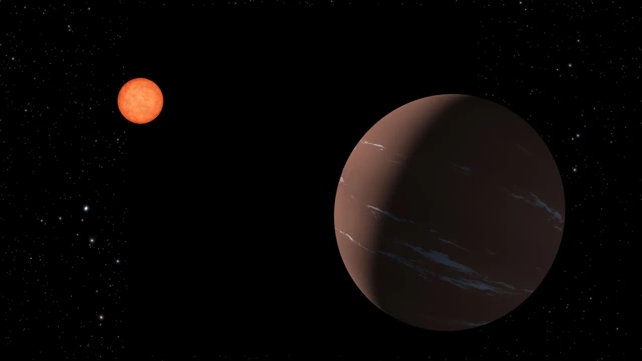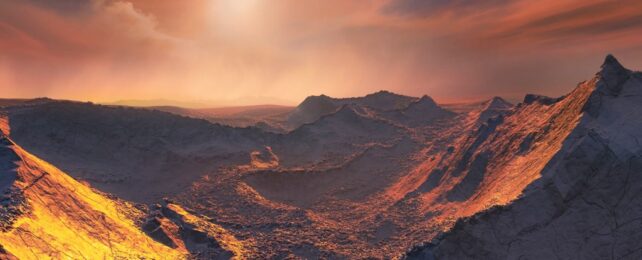Astronomers have found a new Super-Earth orbiting an M-dwarf (red dwarf) star about 137 light-years away.
The planet is named TOI-715b, and it's about 1.55 Earth's radius and is inside the star's habitable zone. There's also another planetary candidate in the system. It's Earth-sized, and if it's confirmed, it will be the smallest habitable zone planet TESS has discovered so far.
TOI-715 is an average red dwarf. It's about one-quarter the mass and about one-quarter the radius of our Sun. TOI-715b is close to the star, and its tight orbit takes only 19 days to complete one trip around the dwarf star. Since red dwarfs are much dimmer than the Sun, this puts the Super-Earth in the star's conservative habitable zone.
New research published in the Monthly Notices of the Royal Astronomical Society presents the discovery. It's titled "A 1.55 Earth-radius habitable-zone planet hosted by TOI-715, an M4 star near the ecliptic South Pole." The lead author is Georgina Dransfield, from the School of Physics & Astronomy at the University of Birmingham.

The habitable zone is a rather crude way to identify planets that may have liquid water. Its boundaries are unclear and even contradictory since stellar spectral type, planetary albedo, mass, and even how cloudy its atmosphere is can determine if a planet has liquid water.
The idea of a conservative habitable zone (CHZ) is more helpful. It comes from a 2014 paper by Kopparapu et al. It's a region around a star where a rocky planet receives between 0.42 and 0.842 as much solar insolation as Earth does. Any rocky planet receiving that much energy is in the CHZ, regardless of distance.
Discovering a Super-Earth in a star's CHZ is always exciting. It fuels our sense of wonder about other planets and the possibility that some may harbour other life. For that reason, they're more intriguing than planets like Hot Jupiters for instance, which have zero possibility of hosting liquid water or life. Not even the hardiest extremophiles can survive a Hot Jupiter's wicked environment.
But this discovery is also exciting for a couple of other reasons.
"At long last, the era of JWST has arrived, and with it, the age of detailed exoplanetary atmospheric characterization." – From "A 1.55 Earth-radius habitable-zone planet hosted by TOI-715, an M4 star near the ecliptic South Pole."
Now that we've discovered thousands of exoplanets, astronomers are seeing trends in the population. One of the things they noticed is a gap in the small planet population between 1.5 and 2 Earth radii. It's known as the small planet radius gap or the sub-Neptune radius gap (also called the Fulton gap and the photoevaporation valley.) At 1.55 Earth radii, TOI-715b is inside the gap.
It's extremely unlikely that no planets form in this radius gap. Planets must start out larger and lose mass to end up in the gap. So, the Fulton Gap tells us something about how some planets lose mass.
Astronomers think that planets in the gap start out larger, but their stars strip away some of their mass by photoevaporation, shrinking them. That's why it's sometimes called the photoevaporation valley. There's a lot of uncertainty around the valley and photoevaporation, and astronomers want to study planets in the valley to see what they can learn.
"The importance of the radius valley lies in its potential to teach us about planetary formation and post-formation evolution, and hence, planets inside this gap are crucial in furthering our understanding of the factors that sculpt it," the authors explain.
There's some uncertainty if this radius gap exists around M-dwarfs or not. It's possible that M-dwarfs have a density gap rather than a radius gap. "A recent study by Luque & Pallé (2022), however, indicates that M-dwarf planets may have a density gap rather than a radius gap separating two populations of small planets (rocky and water worlds)," the authors write.
Whether it's a radius gap or a density gap, TOI-715b should have something to tell us about exoplanets, photoevaporation, and the nature of exoplanet distribution around red dwarfs. But to discover what it has to tell us requires further, detailed observations. That's the second reason why this Super-Earth is so intriguing.
Ever since we started finding exoplanets, scientists have looked forward to the day when the James Webb Space Telescope is operational.
"At long last, the era of JWST has arrived, and with it, the age of detailed exoplanetary atmospheric characterization," the authors write in their paper. The JWST has the ability to observe the spectra of exoplanet atmospheres and determine their constituents. But even though the JWST is enormously powerful, some targets present better opportunities for transmission spectroscopy than others.
TOI-715b is a prime target because it's close to its star. Since TOI-715 is a small red dwarf, and the planet orbits it every 19 days, the exoplanet's transits in front of its star are deeper and more frequent. That means the JWST doesn't need much time to observe the planet's atmosphere, making it an efficient use of the space telescope's time.
"In the context of atmospheric characterization by transmission spectroscopy, bright, nearby M dwarfs are ideal planetary hosts as small temperate planets will transit frequently, enabling high signal-to-noise detections of atmospheric features with fewer hours of telescope time," the authors explain.
Can this Super-Earth be habitable? Lacking the JWST's spectroscopy, we're reduced to speculating. It's in the conservative habitable zone, but that doesn't get us very far. Still, there are some hopeful signs.
TOI-715 is a little older than our Sun at about 6.6 billion years old. The star shows a "low degree of magnetic activity," according to the authors. That's probably why the star shows an absence of flaring in the TESS light curves compared to younger M-dwarfs. Red dwarfs are known to exhibit extremely powerful flaring that can sterilize planets. They can also strip away atmospheres, which could be responsible for the exoplanet photoevaporation valley.
Another planet may be orbiting TOI-715. It's currently only a candidate named TIC 271971130.02, but if confirmed, it will be the smallest habitable zone planet TESS has ever found. But follow-up observations are needed to confirm it.
The TOI-715 system is a compelling target for further study. TOI-715b is waiting its turn, but eventually, the JWST will examine its atmosphere. If those results support habitability, astronomers' excitement will only grow. At the same time, we may learn more about the radius or density gap, an obstacle to a more thorough understanding of exoplanets.
Add in the fact that the star may host another habitable zone planet, the smallest one found yet by TESS, and the TOI-715 system becomes even more important.
This article was originally published by Universe Today. Read the original article.
